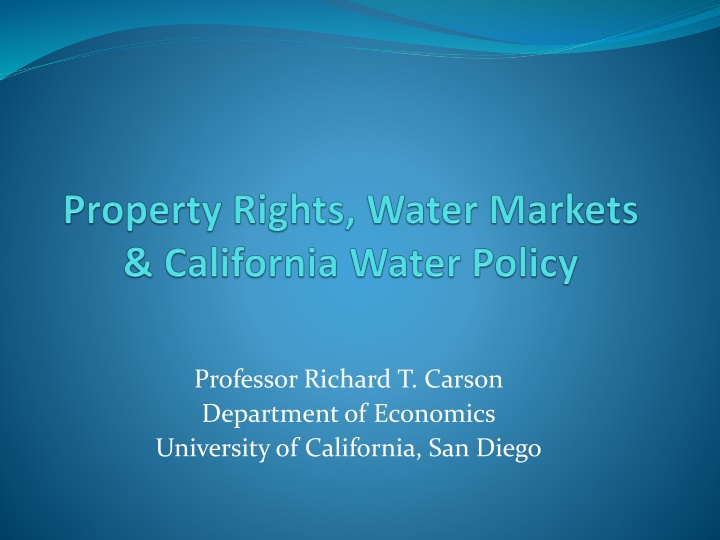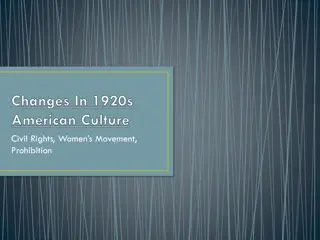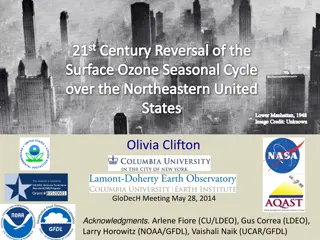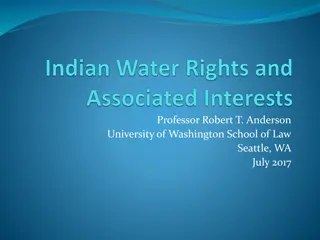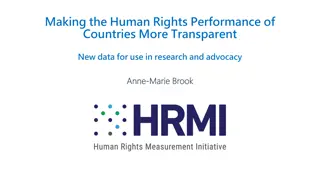Water Grab Game and Surface Water Rights Typology
In this academic study, Professor Richard T. Carson delves into the dynamics of water allocation through the Water Grab Game. The game explores scenarios like how to split water fairly among farms, dealing with temporal variations in river flow, and strategies for subsequent entrants without river frontage. Furthermore, the Surface Water Property Right Typology is examined, covering riparian and state ownership systems, as well as the concept of prior appropriation. The content provides insights into water resource management models and legal frameworks.
Download Presentation

Please find below an Image/Link to download the presentation.
The content on the website is provided AS IS for your information and personal use only. It may not be sold, licensed, or shared on other websites without obtaining consent from the author.If you encounter any issues during the download, it is possible that the publisher has removed the file from their server.
You are allowed to download the files provided on this website for personal or commercial use, subject to the condition that they are used lawfully. All files are the property of their respective owners.
The content on the website is provided AS IS for your information and personal use only. It may not be sold, licensed, or shared on other websites without obtaining consent from the author.
E N D
Presentation Transcript
Professor Richard T. Carson Department of Economics University of California, San Diego
Water Grab Game River
Water Grab Game No Conflict: 1 Farm Farm River
Water Grab Game How to Split the Water? Options: (a) equally, (b) seniority (Farm 1), (c) position on river (Farm 2), (d) proportionate to river frontage or (e) land area, (f) political power Farm 1 River Farm 2
How to Split the Water? Temporal Issues River flow is has little variability Original division rule may work with little modification River flow has substantial variability May induce use of a different rule for low flows than original division Priority to seniority [implicit infrastructure investment] Priority to highest valued use Number of people Type of agricultural production Are there opportunities to trade water?
Water Grab Game How to Treat Subsequent Entrants Options: (a) equally, (b) seniority, (c) position on river, (d) river frontage, (d) land area, (e) political power Farm 1 River Farm 2 Farm 3
Water Grab Game How to Treat Entrants Without River Frontage Options: (a) no rights, (b) purchase water from Farm 2 or 3, or (c) extract from directly from river and transport to Farm 4 Farm 1 River Farm 2 Farm 4 Farm 3
Surface Water Property Right Typology Riparian (English in origin) Water rights based on ownership of land bordering water body Many variants Amount of river frontage Position on river (e.g., more senior rights upstream) State Ownership (Spanish in origin) Often temporarily allocated and then shared Sometime formally given away with conditions In some cases, use without complaint for a sufficiently long period conveyed private ownership rights Prior appropriation First use, associated with mining in western U.S. Right to specific quantity with use it or lose it conditions Sometimes transferable as long as beneficial use
What about water for ecosystems? Usually ill-defined in riparian systems Later times, diminished downstream quality sometimes invoked as constraint State ownership and ability to allocate Government decides Prior appropriation Usually no constraint Current situation hybrid of all three types of water rights
Ground Water Property Right Typology Absolute Ownership/Common Law Water beneath one s land is the property of the landowner and may be withdrawn without regard to the impact on any other landowner American Rule (western U.S.) Withdrawal rights limited to beneficial uses which are typically defined as not taking the water off the land Correlative Rights (California) Recognizes that multiple landowners may over lay a groundwater aquifer. Reasonable beneficial use with equal (proportionate) shares Prior appropriation Sequence of who pumps and what rate. Differences by aquifer seen as depleting over time versus safe-yield if recharging fast enough.
Standard Economic Story Line Tragedy of the Commons New agents enter to exploit the natural resource until the marginal (short run) value of doing so is zero Drives down profits of all users Equivalent to having a infinite discount rate for the future Clear early model put forth by Scott Gordon ( Economic Properties of a Common Property Resource: The Fishery, JPE, 1954) Popularized in the science/ecology literature by Garrett Hardin ( Tragedy of the Common, Science, 1968) Population growth key force in driving problem Solution requires either state control or full privatization
State Owned Solution History of high level state claims to all water resources Goes back to beginning of recorded time Main precedent for U.S. claims by Spanish crown for much of the Southwest Typically very incompletely enforced Recognition that localized control necessary for well functioning society State control implies Ability to reward (temporarily) particular agents Modern attempts environmentally disasterous Soviet Union
Usual Economic Recommendation Fully delineate complete property rights to water Rights incorporate stochastic nature of flows Make those rights fully transferable/tradeable Institutions to exchange, monitor/enforce transactions needed If water is deemed to be publically owned: Auction off rights so that public gains full resource rent Auction off either permanently or with long lease to ensure adequate infrastructure investment If water is needed for ecosystem support determine optimal quantity in different contexts and alter quantity/nature of water rights auctioned to agents If supply of water to households/firms is deemed to have elements of a natural monopoly then Regulate as a monopoly Equity concerns might suggest lifeline block for small usage
Early Comprehensive Econ View of Water Water Supply: Economics, Technology and Policy Hirshleifer, De Haven, Milliman (U. Chicago Press, 1960) Study funded internally by Rand Built on earlier work by Gordon and Scott work on commons/fisheries Green book (Congressional subcommittee on Federal projects, 1950/1958) Harvard Water project (Eckstein, Krutilla and others) McKean (Efficiency in Government through Systems Analysis, Wiley, 1958) Reaction against major Federal efforts/reports on water Reaction against big California & New York water projects
Many of the conclusions of the book are likely to be controversial. This is so because these conclusions are often at variance with present practice governing existing water supplies.
Conclusions/Recomendations Complete rejection of water-is-different philosophy Water does have a number of characteristics which make it an interesting/difficult good to develop appropriate policies for Water misallocation across sectors Water mispriced within sectors Confusion over average versus marginal cost Large amounts of cross-subsidization Benefit/cost estimation Dubious benefits (e.g., employment) included Environmental harm not included Lowest cost supply frequently not used Inappropriately low discount rates used
Communal Control Story Line People at the local community level develop informal rules/social norms which solve or substantially mitigate commons problem Argument most closely associated with Elinor Ostrom (Governing the Commons: The Evolution of Collective Action, Cambridge University Press, 1990) Richard Norgaard (Development Betrayed, Routledge, 1994) Ostrom, Burger, Rield, Norgaard, Policansky ( Revisiting the Commons: Local Lessons, Global Challenges, Science, 1999)
Five Basic Insights In addition to open access, government control and individual property rights there are group/community rights Lots of successful empirical examples of communities overcoming commons issues around the world Historical custom/social norms play a large role Success stories usually from small homogenous groups Success stories usual involve some way of controlling: New entrants Free riding with respect to maintenance
Game Theoretic Underpinnings Gordon/Hardin framework essential a prisoner s dilemma No ability to make binding commitments with respect to: New entrants Future actions Early work in experimental economics show various ways out of the prisoner s dilemma with repeated play People more altruistic than pure self-interested assumption Cooperation if started often continues Axelrod s tit-for-tat play typically won contests Weak sanctions often encourage/sustain cooperation Coase flavor whereby group membership serves to reduce transactions cost and hence bargaining tends toward an efficient allocation
Where Does Communal Model Breakdown? Group size becomes large Little power over new entrants Cannot deter entry Cannot extract side payments to join group Unable to impose sanctions on members not contributing fair share of maintenance activities Amount of use by group members not easily observed Stochastic aspects of resource not well understood Group decision rule on allocation lacks: Transparency Perceived fairness Efficiency (economic)
World Bank View Water in Developing Countries Water problems are serious in many countries Water is badly misallocated in many instances Poor households disproportionately and adversely impacted by current water policies Economic efficiency/equity tradeoffs often poorly thought out Standard criteria for allocating water inherently contradictory
Criteria for Allocating Water Dinar, Rosegrant, & Meinzen-Dick (1997) Flexibility to meet changing demand Security of tenure for established users Real opportunity cost (including environmental externalities) paid by users Predictability of allocation process Minimization of transactions cost Perceived equity of allocation process Political/public acceptability Effective at moving system toward desire objectives Administrative feasibility/sustainability
Standard List of Allocation Options Marginal cost pricing Advantage: economically efficient outcome Disadvantage: difficult to measure, not constant across time, equity issues Public/Administrative Allocation Advantage: political acceptability Disadvantages: most costly, lack of incentives to conserve, subsidization of large scale projects (irrigation) Water Markets Advantage: efficient use and allocation across sectors, encourages appropriate infrastructure investment Disadvantage: difficulties of implementing with stochastic flows & externalities, opposition from those with current implicit/explicit rights User Based Allocations Advantage: flexibility in meeting local needs/changing situations Disadvantage: requires some form of reasonably strong implicit/explicit community property rights, unable to deal with cross sector allocation issues
Rosegrant and Binswanger (1994) What water policies can lead to efficient increases in irrigation production while reducing resource degradation in the irrigated areas in developing countries releasing water for growing nonagricultural demands? Policies employed fall into four categories: Technological solutions Public management of irrigation systems Communal management Tradable water rights Only the first three have been extensively employed
Two questions Have the first three approaches worked? Why have tradable water rights not worked?
Technological solutions Tend to be large infrastructure projects Popular with politicians Look like bad investments from World Bank s perspective Bottom line: rent seeking and subsidization Public management of irrigation systems Mixed results Some pricing reforms and improvement of worst cases But generally run in fairly inefficient and often arbitrary way
Communal water management Farmer/community management is popular idea at World Bank Communal management no worse than public management and often facilitates resolution of local conflicts No indication communal management results in Increased farm production Increased farm income Improved access to water Clear demarcation of duties between community and government Greater ability to solve conflicts across communities
Water Markets Usual economic view is that water markets are substitutes for the other three approaches Rosegrant and Binswanger/Dinar et al. argument that they may be complements: More costly water improves conservation and secure property rights should result in better technology choices With government out of many routine pricing decisions can focus on rules of the game for trades and reducing transactions costs Communities can be given/buy water rights. Trade sets the price of buying/selling water and allows decisions to be made which benefit the community rather than zero sum game
Forces working against use of water markets Price of water is too low (government subsidies are high) Usual some group/class of agents with implicit rights who will lose under formal water markets Engage in considerable rent seeking to block Resolvable by giving rights to current users but at public s expense Fear water will get transferred out of agriculture to cities Adverse secondary impacts on agricultural areas High cost/insecure transactions Difficulties defining/measuring water use Variability in the water supply Two approaches: Proportionate to stream flow Seniority in taking specified volumes Treatment of return flows Examples of use of water markets while limited are expanding around the world: Chile, India, Mexico, Pakistan
Adams, Rausser & Simon (JEBO, 1996) Modeling Multilateral Negotiations An Application to California Water Policy Try to capture key features of large messy policy negotiations between interested parties Key feature 1: regulator can impose solution if parties do not agree. Solution may be undesirable to all. Key feature 2: multiple parties Key feature 3: policy is multidimensional Key feature 4: negotiations are multi-period Key feature 5: parties agree on ground rules for talks Key feature 6: some parties have more influence Key feature 7: each party represents larger set of members
Three parties Agricultural water districts/irrigators Urban water districts/consumers/industry Environmental groups Agriculture Strongly oppose water for environment Wants more infrastructure Weakly oppose water markets Urban Strongly favors water markets Wants more infrastructure Weakly opposes water for the environment Environmentalists Strongly favors water for the environment Opposes infrastructure Weakly opposes water markets
Analysis Plan Objective: look at how features of the game influence outcomes using simulation Set-up Define utility function/parameters Define negotiating range/parameters Define outside solution/parameters Vary key parameters
Basic Results Expanding the negotiating space can Make agreement more likely Lower or raise utility of all actors Shifting the disagreement point toward one actor s ideal point strengthen their bargaining power Heterogeneity in a party s members positions weakens that party s bargaining power if they can defect. Ability of party to make proposals and their sequence can be important Agreement often possible
Murphy, Dinar, Howitt, Rassenti & Smith Design of Smart Water Market Institutions Using Laboratory Experiments (ERE, 2000) Use the smart market concept of McCabe, Rassenti and Smith (Science, 1991) Computer solves for outcome given participant input Technological constraints and information availability important Uniform double price auction provides market clearing price. Ability to query for information/prices up to time market closes Computer coordinates flow of water given submitted bids and maximizes total gain (without regard to agent identities) given those bids
Three types of agents Water buyers Water sellers Water transporters Agents stylized representations of actual California water districts (e.g., San Diego) Four agricultural water districts Three with access to groundwater Five urban water districts Different representations of water conveyors Monopoly versus competitive
Moving Parts Consumption of water Agriculture Urban Supply of water Surface water (stochastic supply) Groundwater Transportation of water Constraints on environmental flows Cost of conveying water
Results Based on repeated trials under different conditions over a two day intensive session with same group of University of Arizona undergraduates Market is thin Outcomes often strongly influenced by aberrant behavior by one agent Profit maximizing opportunities often missed Substantial variability in responses Substantial market power System slow to respond to variability in supply Average efficiency relatively high in spite of these problems Gains from trade sizeable
Critics Stylized View of World Bank Induced Water Disaster Communal management with village water tank World Bank comes in (India/Pakistan) Provides loans for shallow tube wells Farmers/households put in such wells People don t have to go substantial distances for water Agricultural yields go up Village tank falls into disrepair Tube wells start going dry after a few years Community starts to fall apart
The (Nine) Principles of Water Democracy Vandana Shiva (South End Press, 2002) Water Wars: Privatization, Pollution & Profit 1. Water is nature s gift We receive water freely to nature. We owe it to nature to use this given in accordance with our sustenance needs, to keep it clean and inadequate quantity. Diversions that create arid or water logged regions violate the principles of ecological democracy. 2. Water is essential to life Water is the source of life for all species. All species and ecosystems have a right to their share of water on the planet
3. Life is interconnected through water Water connects all beings and all parts of the planet through the water cycle. We all have a duty to ensure that our actions do not cause harm to other species and other people. 4. Water must be free for sustenance needs Since nature gives water to us free of cost, buying and selling it for profit violates our inherent right to nature s gift and denies the poor of their human rights. 5. Water is limited and can be exhausted Water is limited and exhaustible if used nonsustainably. Nonsustainable use includes extracting more water from ecosystems than nature can recharge (ecological nonsustainability) and consuming more than one s legimate share, given the rights of others to a fair share (social nonsustainability).
6. Water must be conserved Everyone has a duty to conserve water and use water sustainably, within ecological and just limits. 7. Water is a commons Water is not a human invention. It cannot be bound and has no boundaries. It is by nature a commons. It cannot be owned as a private property and sold as a commodity. 8. No one holds a right to destroy No one has a right to overuse, abuse, waste, or pollute water systems. Tradeable-pollution permits violate the principle of sustainable and just use. 9. Water cannot be substituted Water is intrinsically different from other resources and products. It cannot be treated as a commodity.
California and Water History Some current facts Current policy issues
History The Long View Good Source: Norris Hundley (2001) The Great Thirst: Californians and Water History (University of California Press) Indian (Pre-Spanish) California support sizeable population (300,000) Most of the population lived in the interior along the large rivers. Largely existed on fishing (salmon, steelhead) & hunting Irrigation developed in Owens Valley & along Colorado No influence on current water situation
Spanish Settle along the coast where settlements could be supplied by ship Used a combination of religion (missions) and military Initial settlements on good harbors & fresh water supply San Diego (1769), Monterrey (1770), San Francisco (1777), Santa Barbara (1782) Other missions and settlements (pueblos) fill in: San Jose (1777), Los Angeles (1781) Spanish Crown asserts total control of water Land/water though said to be held in trust for Indians
Spain and California similar Arid Water supply variable Spanish water customs/law applied to both Crown grants settlements temporary water rights Many settlements have substantial problems/failure Water shortages Agricultural production issues Custom is proportionate sharing of water Including shared responsibility to maintain system Issues arise in sharing water/other provisions across missions and pueblos Formal procedures for designated Royal official to adjudicate water (and related land boundary) conflicts Often slow
Water problems expand Settlements along coast grow taxing water supplies at some times of the year Spanish Crown desires settlements in interior Conflicts with damming upstream water supplies Develops into a system of senior do no harm rights Spanish Crown desires to give away large land parcels for ranchos Water on land usable for livestock & domestic purposes Could petition to irrigate limited (10%) amount of land Property rights could be obtained if water used for some purpose, typically irrigation, for 10 years and no complaints lodged with authorities This custom influences later western U.S. water law
Spanish water law impacts western United States via Custom 1848 Treaty of Guadalupe Hidalgo ending war with Mexico Most important case was Los Angeles assertion of pueblo water rights claiming water from the Los Angeles river California s Indian population had declined by 50% (to 150,000) during Spanish/Mexican rule. Declined to 20,000 by 1900 under American rule. California non-Indian population booms from 10,000 in 1846 to 100,000 in 1849 to 1.5 million in 1900.
